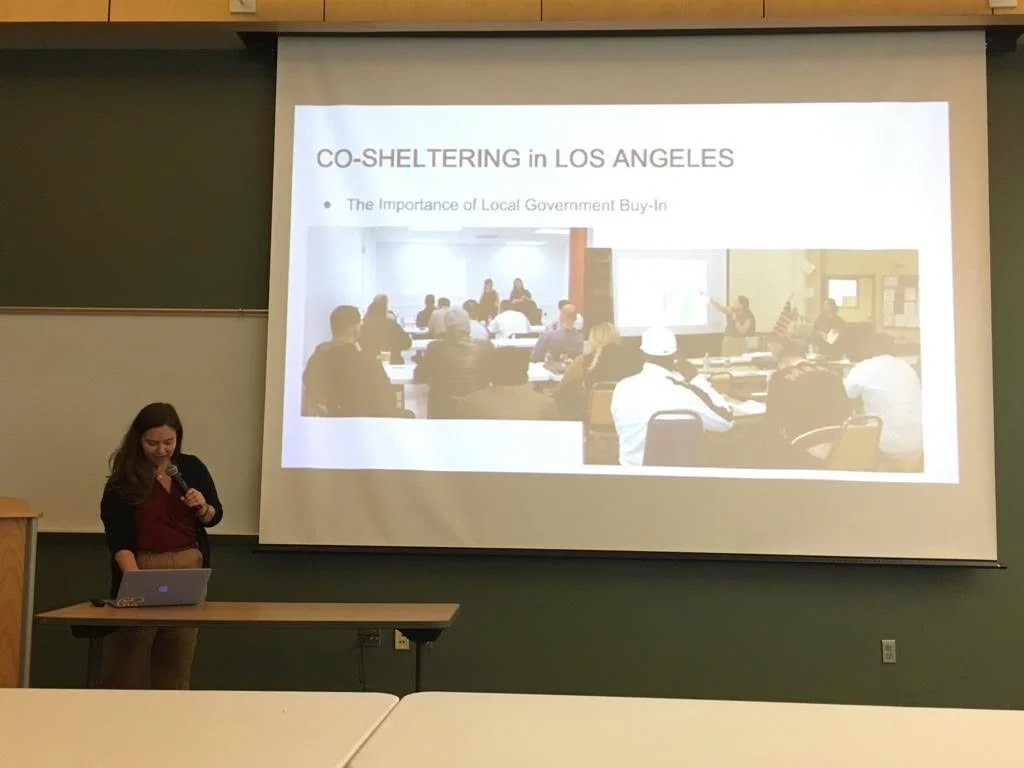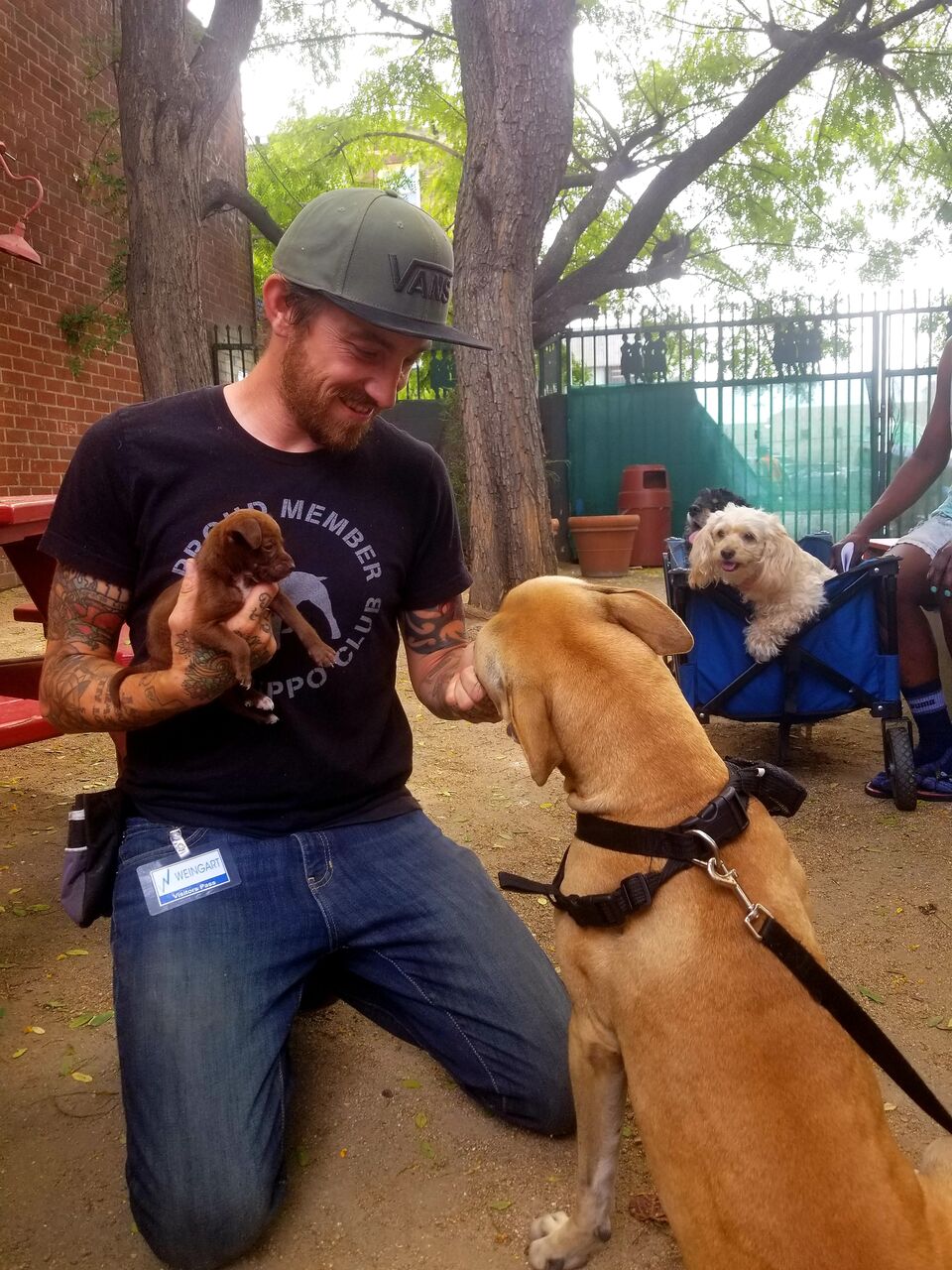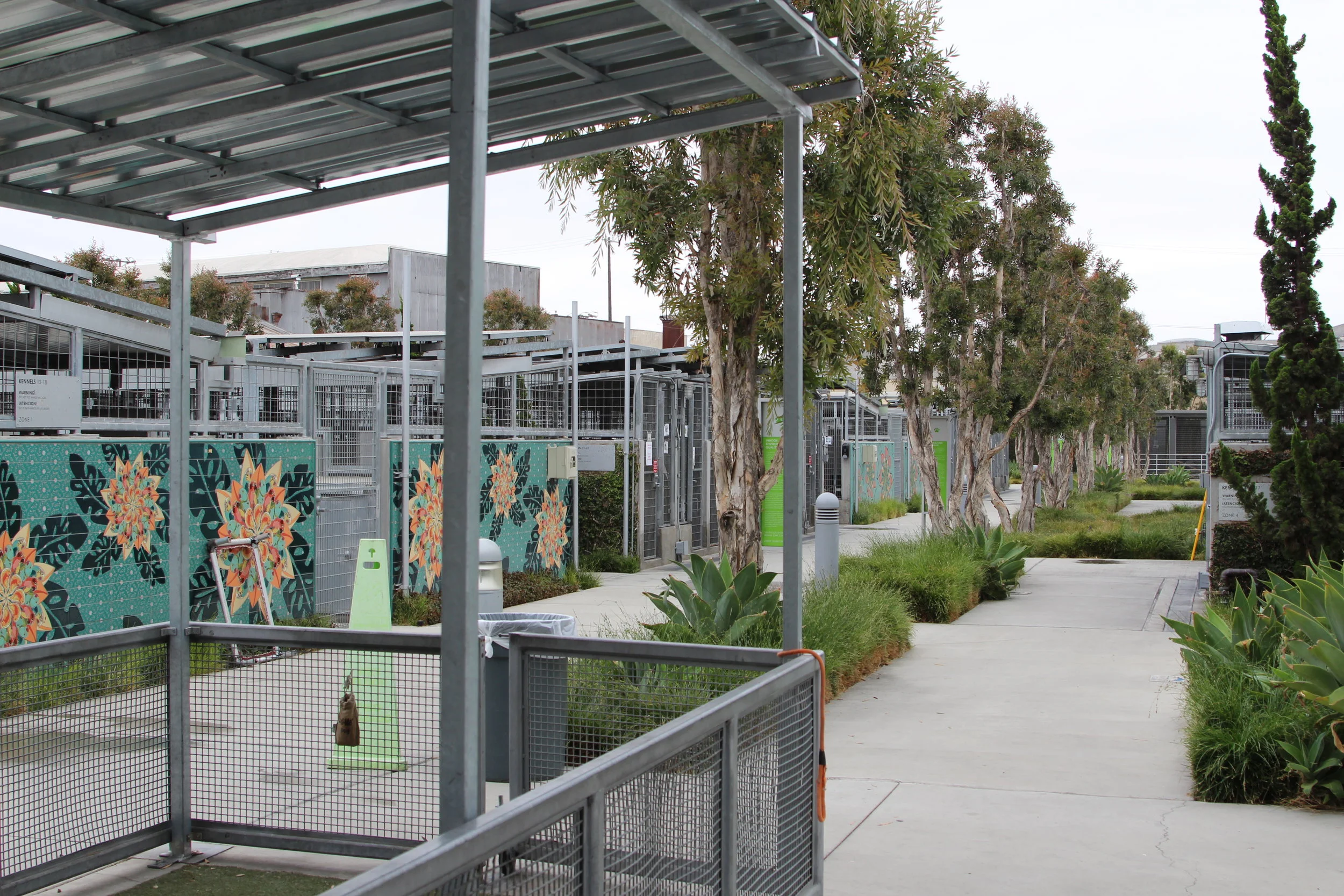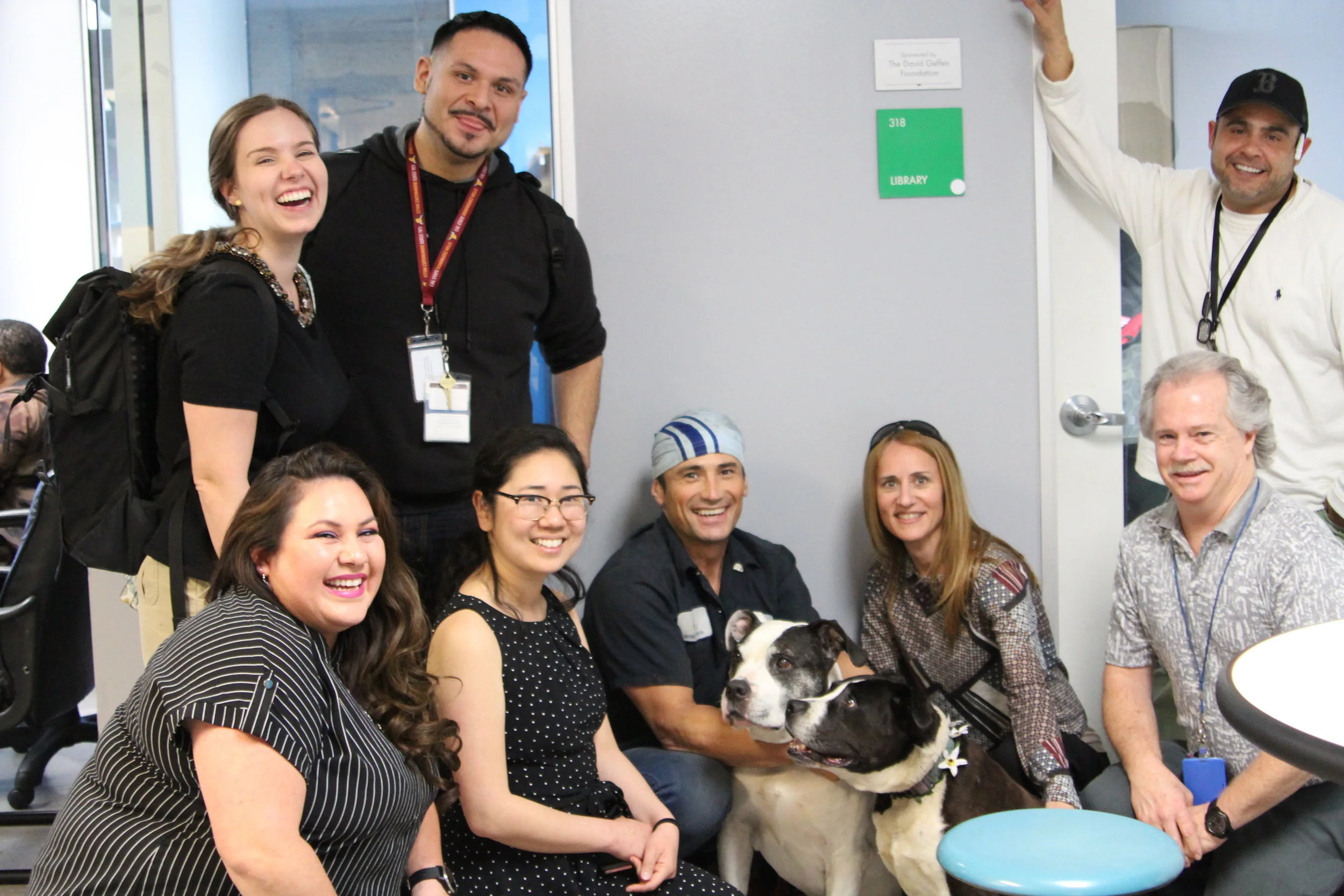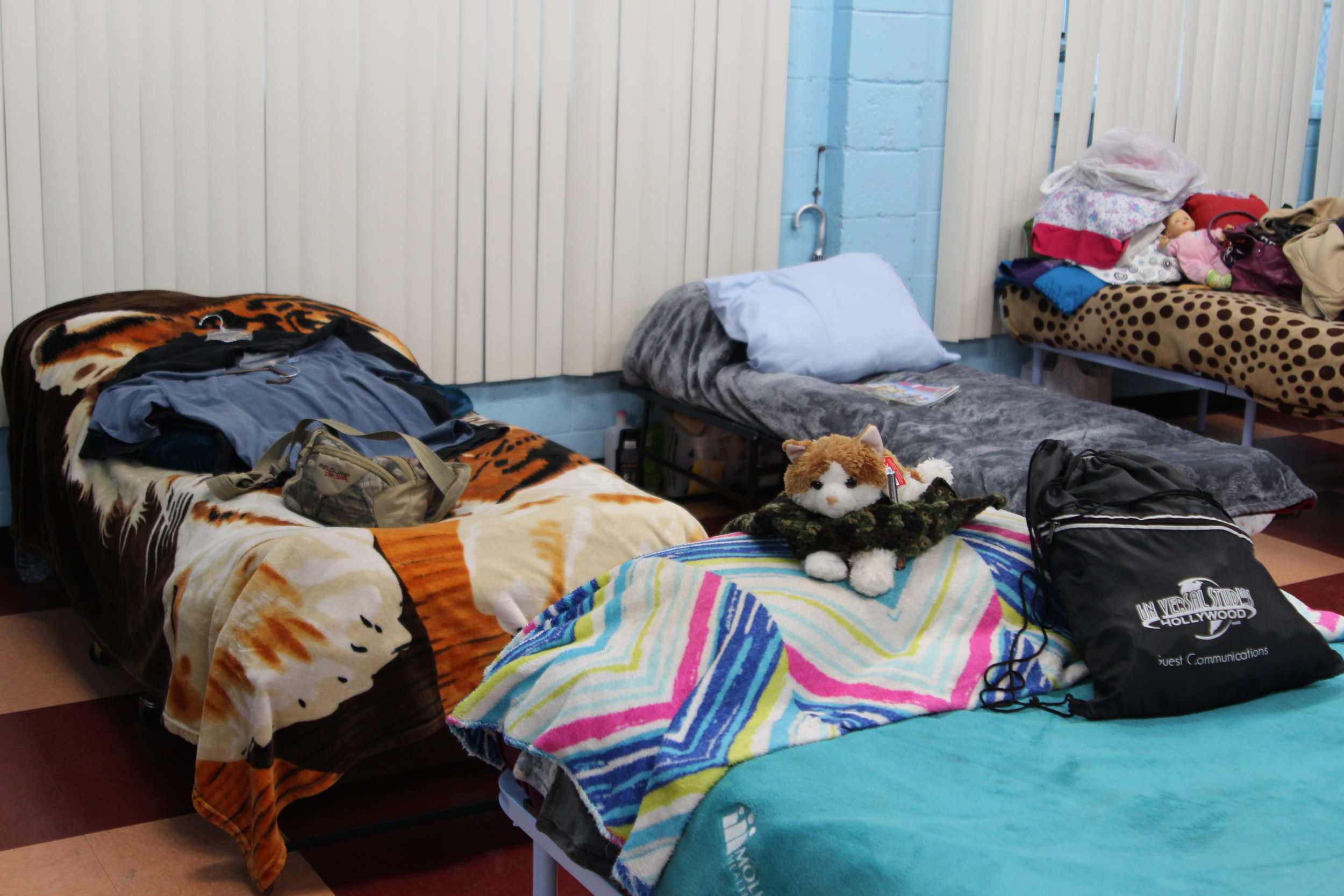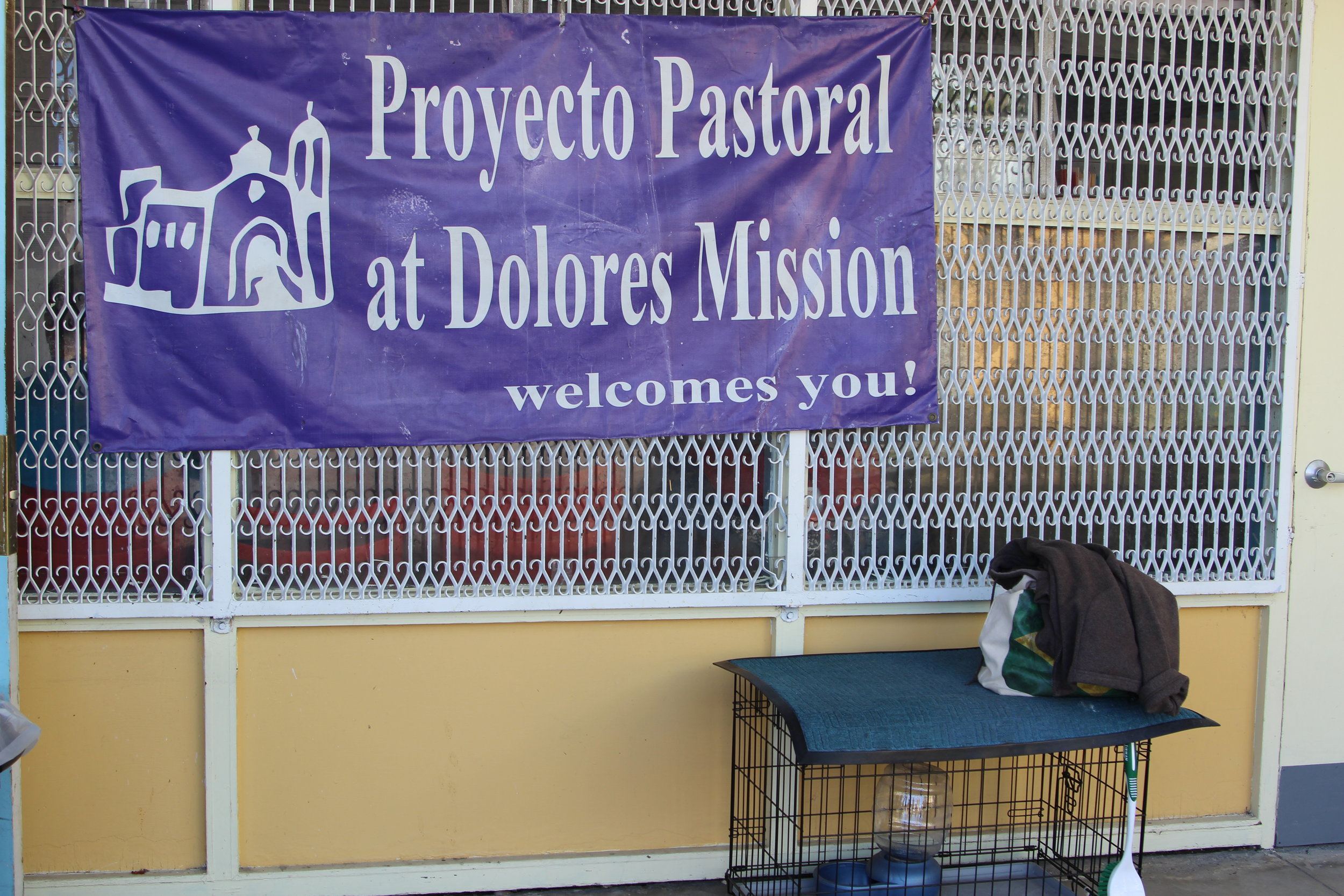
My Dog Is My Home and Found House Co-host Co-Sheltering Collaborative Open House in Cincinnati to Showcase Pet-Inclusive Homeless Services
Special guests from Representative Brad Wenstrup and Senator JD Vance’s Office attend Open House to show support for keeping people and animals together in times of crisis
August 4, 2023
Cincinnati, OH: On August 4th, 2023 My Dog Is My Home, a non-profit that advocates for access to shelter and housing for people experiencing homelessness with their companion animals, hosted a Co-Sheltering Collaborative Open House with Found House Interfaith Housing Network. Animal welfare organizations, homeless services providers, and elected officials came together to learn about Found House’s newly opened, fully pet-inclusive supportive housing program and Pet Support Program. Representative Brad Wenstrup (R-OH-02) and Senator JD Vance’s (R-OH) offices attended the Open House to support pet-inclusive policies and programs.
Restrictive pet policies in shelters and affordable housing are a barrier to essential services. People experiencing homelessness and housing insecurity will often delay or refuse needed services to avoid living without their companion animal. Others are forced to surrender their pets to animal shelters, causing stress to the family and to already overcrowded animal shelters. My Dog Is My Home highlighted Found House’s model and programs as an example of pet-inclusive homelessness and housing services for other providers to follow.
During the open house, My Dog Is My Home’s Founder, Christine Kim, spoke about the Providing for Unhoused People with Pets Act, or the PUPP Act, which is currently making its way through Congress. This Act would establish a $5 million grant program per fiscal year from 2024 - 2028 that would support emergency shelter or permanent supportive housing providers in expanding their animal accommodations. Kim explained, “People need their pets for emotional support. This bill supports the human-animal bond and helps people stay with their animals when they need them the most. My Dog Is My Home thanks Representative Wenstrup and Senator Vance for recognizing the importance of animals in the lives of people recovering from trauma, including our nation’s homeless veterans.”
In addition to the pet-inclusive supportive housing program Found House opened in April 2023, they have been operating the Pet Support Program for nearly a decade. The Pet Support Program provides temporary boarding for animals whose owners are seeking emergency shelter, medical care, or rehabilitation services. Found House’s Pet Support Program also provides pet food and veterinary care resources to low income pet owners.
“When a single Dad and his teenage son came to shelter after living in their truck with their dog, they asked, do we really have to give him up, to get help? He’s been with us for 13 years and he is family. Of course, the answer was no. We could not serve families and tell them which members counted, and which did not. Not with any integrity. From housing that dog in a staff office, our Pet Support Program was born.”
About My Dog Is My Home: My Dog Is My Home, a national nonprofit organization, is dedicated to increasing access to shelter and housing for people experiencing homelessness with companion animals. My Dog Is My Home assists service providers like homeless shelters expand their programming to allow humans and their companion animals to remain together.
About Found House Interfaith Housing Network: Found House Interfaith Housing Network provides homeless families emergency shelter and hospitality through interfaith communities and works with families to find and retain stable housing. Established in 2014, the Pet Support Program is a pet shelter embedded into Found House IHN’s social service center providing a coordinated network of care for people and pets experiencing the crisis of homelessness, or related crisis, with the central goal to keep people and their pets safe and together.
###
Media Contact
christine@mydogismyhome.org
(213) 705-7363
SB258 Legislation Update!
Earlier this year, Senate Bill 258 was proposed and passed the Senate in May. This bill has now made its way into the Assembly and had a scheduled hearing on August 30th!
A homeless person or family should not have to choose between basic human needs and their pets. Homeless people experience struggle on a daily basis, and their pet is family.
Earlier this year, Senate Bill 258 was proposed and passed the Senate in May. This bill has now made its way into the Assembly and had a scheduled hearing on August 30th!
A homeless person or family should not have to choose between basic human needs and their pets. Homeless people experience struggle on a daily basis, and their pet is family.
New California Senate Bill 258 “Support Both Ends of The Leash” would provide funding for California homeless shelters to provide food, shelter, and veterinary services to homeless people and their pets. This legislation is crucial as it would appropriate $5,000,000 from the General Fund to the Department of Community Services & Development for this grant program.
The Unintended Consequences of a Mandatory Bill
A Senate Bill has recently been introduced in Sacramento, CA that would mandate microchipping for all cats and dogs that pass through the state’s animal shelters. This bill has the potential to successfully address the influx and overpopulation of lost animals in county and city animal shelters due to the inability for non-chipped companion animals to be reunited with their owners. While, on the surface, this bill may seem like a solution to a pressing problem, this mandatory legislation could generate unintended consequences for individuals experiencing homelessness.
A Senate Bill has recently been introduced in Sacramento, CA that would mandate microchipping for all cats and dogs that pass through the state’s animal shelters. This bill has the potential to successfully address the influx and overpopulation of lost animals in county and city animal shelters due to the inability for non-chipped companion animals to be reunited with their owners. While, on the surface, this bill may seem like a solution to a pressing problem, this mandatory legislation could generate unintended consequences for individuals experiencing homelessness.
SB64 is written with a specific “type” of a citizen in mind. The legislation assumes all individuals with pets have a permanent address, phone number, or other kinds of reliable contact information to be inputted into the microchip. This bill fails to recognize the magnitude of individuals experiencing homelessness with companion animals in CA and how this mandatory requirement may impact this population in their ability to comply with the law should it pass.
Another barrier to this bill is the cost. What are the cost implications for the state to demand the microchipping of all animals, if some animals, even with a chip, cannot be returned to their human-companion due to a lack of home address or phone number? How will SB64 address citizens experiencing homelessness? Will it penalize or require an individual to pay for microchipping if his/her companion animal enters the shelter system? Will it further force individuals experiencing homelessness to separate from their animals due to unmanageable fees associated with microchipping costs? SB64 leaves a lot of questions unanswered.
While My Dog Is My Home does not endorse nor reject SB64, we do feel that there are significant gaps in its construction. While there is no one simple solution to making legislation inclusive to all, we can at least make an effort to ensure legislation it is not working against vulnerable individuals as we continue to find effective policy solutions to some of our most pressing societal problems.
LA's Homelessness Initiative Needs to go Further
Ending homelessness in Los Angeles can be an emotionally charged issue. Mayor Eric Garcetti’s new initiative to open low-barrier emergency shelters in every district of LA has garnered a variety of intense responses from communities across the city. A low-barrier shelter is one that minimizes obstacles to entry, including sobriety requirements, official identification, and paperwork. Low-barrier shelters also accept companion animals (pets) ---not just service and emotional support animals that are required to be accommodated under federal law.
Ending homelessness in Los Angeles can be an emotionally charged issue. Mayor Eric Garcetti’s new initiative to open low-barrier emergency shelters in every district of LA has garnered a variety of intense responses from communities across the city. A low-barrier shelter is one that minimizes obstacles to entry, including sobriety requirements, official identification, and paperwork. Low-barrier shelters also accept companion animals (pets) ---not just service and emotional support animals that are required to be accommodated under federal law.
However, how these shelters will accept pets hasn’t received much attention. In all of the reactions to Mayor Garcetti’s initiative, no one has asked how the city and the contracting providers are going to successfully adhere to their low-barrier goals by co-sheltering people and their pets together at the same facility.
As a national non-profit that specializes in supporting homeless service providers in increasing their animal accommodation practices, My Dog Is My Home believes we can’t let this aspect of planning a successful low-barrier shelter go unaddressed.
Individuals experiencing homelessness with animals often fall through the cracks due to the “No Pets Allowed” rule common to many bridge housing and emergency shelters. Because they are denied access to temporary housing, people experiencing homelessness with animals often have difficulty obtaining permanent housing as well. We believe the mayor’s “ Bridge Home” plan has the potential to address this gap.
However, low-barrier services that consider the needs of companion animals must be planned and implemented with care. In order to protect the health of people, animals and the public in these shared spaces, these plans must include hygiene practices that control fleas, address animal behavior training for shelter clients and staff, facilitate access to veterinary medicine, and food resources. At this time, the city’s plan does not address all of these necessities.
We recommend that the city assemble a committee to address the concerns outlined above. Without careful consideration of these needs, the success of Los Angeles co-sheltering pioneers like People Assisting the Homeless (PATH) will not be mirrored in the newly proposed shelters.
We know that the city has many priorities as it sets out to execute this plan, but we urge the city to give thoughtful consideration to the implementation of low-barrier standards involving human-animal co-sheltering to ensure success.
CA Advocacy Alert- "Support Both Ends of the Leash!"
A new California Bill Senate Bill 258 “Support Both Ends of The Leash” would provide funding for California homeless shelters to provide food, shelter, and veterinary services to homeless people and their pets. This proposed legislation will provide CA homeless shelters with the resources needed to offer veterinary services, food, and shelter to the homeless population and their pets.
A homeless person or family should not have to choose between basic human needs and their pet.
A new California Bill Senate Bill 258 “Support Both Ends of The Leash” would provide funding for California homeless shelters to provide food, shelter, and veterinary services to homeless people and their pets. This proposed legislation will provide CA homeless shelters with the resources needed to offer veterinary services, food, and shelter to the homeless population and their pets.
The bill would appropriate $5,000,000 from the General Fund to the Department of Community Services & Development for this grant program. In order for CA homeless shelters to be eligible for a grant under this program, they must:
Establish rules of conduct and responsibility regarding pets and their owners.
Provide crates or kenneling either near bunks or in a separate area.
Provide food for both homeless people and their pets.
Offer the services of a veterinarian, including spay and neutering services.
This bill has the potential to:
Provide California homeless shelters with funds needed to implement services for homeless people and their pets;
Make it easier on homeless people’s pets receive the care they need; and
Reduce the stigma of homeless individuals with pets who refused housing in order to stay with their family member.
SB 258 will be heard in front of the Senate Committee on Human Services on March 25th!
You can contact the committee members of the Senate Committee on Human Services using the emails and phone numbers listed below.
Senator Melissa Hurtado (Chair)
Email: senator.hurtado@senate.ca.gov Phone: (916) 651-4014
Senator Jeff Stone (Vice Chair)
Email: senator.stone@senate.ca.gov Phone: (951) 894-3530
Senator Jim Beall
Email: senator.beall@senate.ca.gov Phone: (408) 558-1295
Senator Hannah-Beth Jackson
Email: senator.jackson@senate.ca.gov Phone: (805) 965-0862
Senator Richard Pan
Email: senator.pan@senate.ca.gov Phone: (916) 262-2904
Senator Scott D. Wiener
Email: senator.wiener@senate.ca.gov Phone: (415) 557-1300
The National Homeless Crisis is Alive and Well in 2018
Report indicates drops in veteran and family homelessness but shows an increase in homelessness and significant racial disparity.
In December 2018 the US Department of Urban Housing and Development released the Annual Homelessness Assessment Report, providing insight on the state of our national homelessness crisis in 2018. To read the full report please click here.
Despite some criticisms that the assessment falls short on effectively reflecting the entire picture of housing needs, it does succeed in giving us a basis to determine what has or hasn’t been working nationally as we strive to reduce the homelessness crisis.
Among some of the more notable findings is the progress that has been made with specific populations of the homeless, such as families and veterans. The number of people experiencing homelessness in families with children has continued to be on the decline, going down two percent between 2017 and 2018, and down by 23 percent over the last 11 years between 2007 and 2018. Additionally, the number of veterans in circumstances of homelessness, both sheltered and unsheltered, has declined by five percent between 2017 and 2018 and has dropped by 48 percent since 2009.
However, homelessness nationally across all populations has increased for the second year in a row at a 0.3 percent increase on a single night between 2017 and 2018. Between 2017 and 2018, the population of unsheltered individuals increased by two percent (or 4,300 people).
Another valuable takeaway from the assessment is the undeniable prevalence of racial disparity in the homelessness system. While making up just 13% of the overall US population, African Americans account for 40% of the homeless population and 51% of individuals experiencing homelessness in a family. This data illuminates the need for a rise in awareness and action to address the deep-seated racial inequity in homelessness and access to preventative and emergency services.
Additionally, the AHAR further demonstrates the degree of the nation’s housing crisis and the need for emphasis on affordable housing regardless of homelessness. The areas with the highest concentration of individuals experiencing homelessness (New York, Oregon, California, Hawaii, and Washington) are directly linked to some of the highest housing costs in the nation.
Overall, the Annual Homelessness Assessment Report reveals the need for continued advocacy and action by all communities and homeless and governmental agencies. Where there is progress we should celebrate and continue to strive to generate sustainability within the areas of improvement.. Where there is regression we need to dig deeper and find better and more impactful solutions that address racial disparities and prevent homelessness. At My Dog Is My Home we continue to advocate for accessible shelter to expand the reach of shelters and homeless services, increasing capacity and reducing the number of unsheltered individuals by shifting the definition of family from human-centric to a human-animal lens. We hope wherever your focus is on with this national homeless crisis that 2019 is the year where we all work together to truly turn the tide on homelessness.
5th International Veterinary Social Work Summit
This month My Dog is My Home had the opportunity to attend and participate in the Fifth International Veterinary Social Work Summit at the University of Knoxville Tennessee. The conference had the theme of “Animals and Poverty” and brought veterinarians, social workers, and advocates from across the world for a three days gathering to address issues of homelessness and non-human animals in poverty as well as access to care and barriers to support.
This month My Dog is My Home had the opportunity to attend and participate in the Fifth International Veterinary Social Work Summit at the University of Knoxville Tennessee. The conference had the theme of “Animals and Poverty” and brought veterinarians, social workers, and advocates from across the world for a three days gathering to address issues of homelessness and non-human animals in poverty as well as access to care and barriers to support.
Our Executive Director, Emma Newton spoke at the conference along with Janet Hoy-Gerlach, Ph.D. from the University of Toledo and William Giles, DVM of WisCARES at the University of Wisconsin in a presentation entitled: “Emerging Models of Animal Accommodations in Homeless Services”. Emma spoke to the groundbreaking work being done in Los Angeles to Co-Shelter humans and animals together in the same facility and how programs can be expanded to successfully include pets in a co-sheltering environment.
Dr. Giles spoke to WisCARES a very successful partnership at the University of the Wisconsin Madison that provides emergency foster and boarding care for pets of the homeless as well as much needed public health and veterinary medicine. Dr. Giles spoke in depth to the pipeline that access to veterinary care for individuals experiencing homelessness can create to get homeless individuals much needed human health care.
Dr. Hoy-Gerlach spoke to her emergency/foster boarding program in Toledo, Ohio that provides a safe temporary space for the pets of those experiencing homelessness as they access to shelter. Dr. Hoy-Gerlach spoke to the importance of building trust with the clients and to focus on reunification between individual and animal.
Veterinary Social Work is a growing field that has the capacity to impact the homeless and animal welfare sphere when it comes to decreasing barriers to health care and shelter and increasing access to life-saving services for all individuals whether two or four-legged.
My Dog Is My Home was proud to present alongside Dr. Giles and Dr. Hoy-Gerlach and contribute to this important conversation at the Fifth International Veterinary Social Work Summit.
For more information about the summit visit UTK’s website at http://vetsocialwork.utk.edu/5th_ivsws/
Advocacy Opportunity: Full-Service Bronx Animal Shelter
New York City has the highest population of individuals experiencing homeless and yet no homeless shelters in NY allow animal companions.
Animal Care Centers, which operates NYC’s animal shelters, offers one of the only stop gap measures to keep human-animal families intact in circumstances of homelessness. They offer pet retention programs that foster or board companion animals until they can be reunified with their family.
New York City has the highest population of individuals experiencing homelessness and yet no homeless shelters in NY allow animal companions.
Animal Care Centers, which operates NYC’s animal shelters, offers one of the only stop-gap measures to keep human-animal families intact in circumstances of homelessness. They offer pet retention programs that foster or board companion animals until they can be reunified with their family.
Without NYC’s Animal Care Centers, many humans with animals cannot access services and are at risk for remaining unsheltered or having to surrender their companions. A full-service animal shelter with Animal Care Center services has been proposed to be constructed on Bartow Avenue in the Bronx. This historically under-served area continues to lack adequate services for the city’s animals. With the help of this new shelter there is a potential to save thousands of animal's lives a year through its preventive community programs and support NYC’s homeless population. The shelter would also be a community resource, offering services such as community training and education, surrender prevention counseling, and community programming for youth and seniors.
If the Bartow Avenue site is not approved, this will force the city to go back to the drawing board to identify sites and delay the shelter for several years. Leaving some of NYC’s most vulnerable residents out in the cold.
At this time the Bronx animal shelter Land-Use Subcommittee hearing is scheduled for October 9th at 2 PM in the Council Chambers at City Hall. Please consider attending to testify in favor of the shelter!
In the meantime, use the contact info and conversation prompts below to contact your representatives and show your support for New Yorkers experiencing homelessness and the non-human animal residents of New York!
Corey Johnson, Speaker (District Office: 212-564-7757; Legislative Office: 212-788-7210)
Erik Bottcher, Corey Johnson’s Chief of Staff (212-564-7757)
Jason Goldman, Corey Johnson’s Deputy Chief of Staff
Chris Coffey, Corey Johnson’s Senior Strategist
Jeff Campagna, Deputy General Counsel, Land Use Division (212-482-5438)
Mark Levine, Chair, Committee on Health (212-928-6814)
Paul Vallone, Chair, Committee on Economic Development (718-619-8611)
Rafael Salamanca, Chair, Land Use Committee (718-402-6130)
Francisco Moya, Council Member, District 21 (718-651-1917)
Co-Sheltering Collaborative: Kick Off
We are pleased to announce that the pilot year of our Co-Sheltering Collaborative was launched on July 30, 2018. To promote an understanding that accommodating human-animal families in homeless services is both necessary and possible, the Co-Sheltering Collaborative - a national community of homeless service providers and government organizations who are actively working on the implementation of co-sheltering - has been developed to share expertise and showcase examples of innovative programs that address integrated human and animal sheltering needs.
We are pleased to announce that the pilot year of our Co-Sheltering Collaborative was launched on July 30, 2018. To promote an understanding that accommodating human-animal families in homeless services is both necessary and possible, the Co-Sheltering Collaborative - a national community of homeless service providers and government organizations who are actively working on the implementation of co-sheltering - has been developed to share expertise and showcase examples of innovative programs that address integrated human and animal sheltering needs.
In order to foster a paradigm shift towards equitable access to shelter and housing for people
experiencing homelessness with animals, the collaborative provides members with an opportunity to engage in dialogue, improve co-sheltering methods, and create a roadmap for making co-sheltering a part of standard practice.
Our pilot year members:
A Bridge Home: El Pueblo in Downtown Los Angeles
A recent effort by Los Angeles Mayor Eric Garcetti is making it easier than ever to open emergency shelters in communities across the city to provides beds and much needed services to the unsheltered. Garcetti's plan called A Bridge Home enables city council members to identify a site or building adjacent to a high-density homeless population and create an emergency shelter on any land owned or leased by the city.
A recent effort by Los Angeles Mayor Eric Garcetti is making it easier than ever to open emergency shelters in communities across the city to provides beds and much needed services to the unsheltered. Garcetti's plan called A Bridge Home enables city council members to identify a site or building adjacent to a high-density homeless population and create an emergency shelter on any land owned or leased by the city.
As a result of this initiative, shelter plans for the downtown LA encampment area around Union Station are moving ahead. Construction for the El Pueblo facility is scheduled to finish at the end of August, with its first residents moving off the street and into the facility in September. My Dog is My Home is working with staff from The People Concern to make sure animal accommodations are thoughtfully planned at the outset.
Weingart Dog Park Opening
Photo credits: Weingart Center
Congratulations to the Weingart Center on the opening of their brand new on site dog park last Friday! Weingart Center shelters upwards of 600 people daily in their Skid Row facility in downtown Los Angeles. If Weingart Center can accommodate animals, we are confident that other programs can too.
My Dog is My Home thanks Weingart for being a partner in this work to co-shelter people and animals together, and for being a stellar example of how it can be done successfully. It is our pleasure to be a witness to their transformation to truly embrace the #YesDogsAllowed philosophy.
Read the coverage of Weingart's dog park opening in the LA Times and the Daily News.
Dog Training for Homeless Shelter Residents
To promote co-sheltering on a wider scale, we need to make sure the few programs that do accommodate animals on site are positive environments for both clients and their staff. We can't ignore the fact that there is a public health risk when domestic animals and people share congregate spaces. To mitigate the chance of bites, dog fights, and other liabilities, we are encouraging the providers we work with in the Los Angeles area to invest in behavior training for shelter residents with dogs.
Dog trainer Steffen Baldwin, our newest My Dog is My Home volunteer, at work with Weingart Center's shelter residents and their dogs.
To promote co-sheltering on a wider scale, we need to make sure the few programs that do accommodate animals on site are positive environments for both clients and staff. We can't ignore the worry of greater public health risk when animals and people share congregate spaces. To mitigate the chance of bites, dog fights, and other liabilities, we are encouraging the providers we work with in the Los Angeles area to invest in behavior training for shelter residents with dogs.
In late June, our Animal Care Liaison (Dana Teel) provided a Pet Care 101 overview to animal guardians residing at the PATH and Weingart Center shelters in LA. This was the foundation for a longer-term dog behavior program delivered by our volunteer trainer Steffen Baldwin of Save Them Dog Training. Follow his good work (and ours!) on Instagram: Steffen / My Dog is My Home.
Dana Teel, My Dog is My Home's Animal Care Liaison, delivering Pet Care 101 training to Weingart's residents with animals.
Why We Promote Pet Retention Within the Homeless Community
This is the sound of the South LA animal shelter. It can be heard from blocks away, even over the din of rush hour traffic. This sound demonstrates one reason why we promote pet retention within the homeless community.
As animal lovers, we are often asked how we can do this work when people experiencing homelessness can't even take care of themselves, and therefore, they don't have the right to keep an animal.
This is the sound of the South LA animal shelter. It can be heard from blocks away, even over the din of rush hour traffic. This sound demonstrates one reason why we promote pet retention within the homeless community.
As animal lovers, we are often asked how we can do this work when people experiencing homelessness can't even take care of themselves, and therefore, they don't have the right to keep an animal.
To begin, we want to make our perspective on homelessness clear. Homelessness is not a result of an individual “not being able to care for themselves.” There are larger systems that contribute to oppression, trauma, and inequitable distribution of resources and wealth that lead to homelessness. Second, at My Dog is My Home, we think a lot about the definition of family. We think about this in terms of who is allowed to have family and choices that are given or restricted based upon race, class, gender identity, and sexual orientation. What this boils down to for us and our particular mission is that people experiencing homelessness have a right to family, and they have a right to choose that family, just like you and me.
Secondly, there are limited resources for animals that need rescuing and rehoming, ultimately
leaving thousands upon thousands of healthy and lovable animals to be euthanized each year
for lack of people who want to adopt them. Animals who accompany people experiencing
homelessness are often very well loved and cared for. In short, these animals have people who
love them. Save rescue resources for animals that truly need rescuing.
We encourage people to keep the bigger picture in mind. By focusing on the solution - ending
homelessness and poverty - we can work on putting people in a position to care for themselves
and their loved ones rather than spending energy making judgements about who a person can
keep in their company. In the meantime, groups like ours work towards a mission of bridging the gap in what people need and what they have access to.
Call for NYC Film Volunteers
Thanks to a field connection from Human.NYC, we were introduced to Shaunyece and her three cats. We are aiming to capture her experience of being a cat guardian on the streets - both the joys and challenges - and promote her story as an example of why animal accommodations in homeless services is critical. We are looking for reliable volunteers who can assist with filming. The time commitment is two full days of filming over the course of two months. If you'd like to contribute your time and talents, please contact Christine at christine@mydogismyhome.org.
New Federal Plan to End Homelessness is Laudable, but Misses the Mark on Definition of Family
After a year of opening up their federal strategic plan to feedback from the general public, the United States Interagency Council on Homelessness (USICH) has released their new plan to prevent and end homelessness. Home, Together starts out beautifully by calling our attention to the meaning of the word "home" - an idea we hold close to our hearts at My Dog is My Home.
As USICH specifies:
"Home. Because we know that the only true end to homelessness is a safe and stable place to call home.”
After a year of opening up its federal strategic plan to feedback from the general public, the United States Interagency Council on Homelessness (USICH) has released their new plan to prevent and end homelessness. Home, Together starts out beautifully by calling our attention to the meaning of the word "home" - an idea we hold close to our hearts at My Dog is My Home.
According to USICH:
"Home enables our families, friends, and neighbors—indeed, everyone in our nation—to have a platform from which they can pursue economic opportunity. Having a home provides people with better chances for succeeding in school and advancing their careers. It also allows them to take care of their health, build strong families, and give back to their communities."
This spotlight on home shows a shift in thinking: to end homelessness, people must have access to a home, which is more than housing alone. Home is where we feel safe, where we recharge, and for some of us, home is where our dog is.
In general, My Dog is My Home supports the plan and its goals, which would ensure homelessness is rare, brief, and a one-time experience. However, the report fails to make mention of animals, despite being encouraged to do so by MDIMH. See the feedback we sent to USICH in September 2017.
For example, under goal 2, objective 2, USICH outlines the characteristics of an effective emergency shelter and temporary accommodations system:
- Meet the needs of all members of a household and self-defined family and kinship groups, including infants and young children
- Do not turn people away or make access contingent on sobriety, minimum income requirements, or lack of a criminal history
- Do not require family members and partners to separate from one another in order to access shelter
- Ensure that policies and procedures promote dignity and respect for every person seeking or needing shelter
- Provide a safe, decent, welcoming, and appropriate temporary living environment, where daily needs can be met while pathway
In this section, USICH missed the chance to provide a more comprehensive definition of "family," specifically omitting animals. As animal lovers know, dogs, cats, and other furry, feathered, and scaled companions are a part of the family, and we would hope that they would be recognized and treated as such within frameworks such as USICH's guidelines. But as we know well from experience and from our advocacy work, unless those with power specifically name animals as a part of the strategy to end homelessness, things are at risk for staying the same.
There is still a long road ahead in terms of providing access to facilities for human-animal families, but we still believe this is a winnable fight. Though the deadline to officially comment on the USICH strategic plan has expired, you can still let them know your thoughts on social media. USICH has invited us to keep the conversation going by sharing what your community is doing to end homelessness by using the hashtag #HomeTogether.
Do you do direct service in your community? Snap a picture of your clients' fur children (with permission, of course), tag USICH, use the #HomeTogether and #mydogismyhome hashtags, and post it on Facebook, Twitter, or Instagram. Send a message that animals are a part of our families and our homes, and they deserve a place in the federal plan to prevent and end homelessness too.
NAEH WEBINAR: HOW TO MAKE YOUR SHELTER PET FRIENDLY
LA Family Housing's newly renovated dog park.
The National Alliance to End Homelessness is hosting a webinar that will highlight emerging practices for shelters that are accessible to people and their animals. This webinar is the ninth in the Emergency Shelter Webinar Learning Series and will expand on one of the key elements to effective emergency shelter, low-barrier access, by delving into the operations and practices of shelters that are accessible to people and their animals. Join Alliance staff and a shelter provider to learn how to shift philosophy and operations to welcome animal owners and a more vulnerable population into shelters. Our good friends at LA Family Housing will present on practical considerations and creative solutions for shelters to consider when making this shift.
Date: Wed, Aug 8, 2018
Time: 2:00 PM - 3:00 PM EDT
This webinar is free. Click here to register.
Call to Action for NYC Residents: Put Co-Sheltering on Mayor de Blasio's Radar!
There are currently no homeless shelters that allow pets in New York City - the homelessness capital of the US. THIS FRIDAY, we ask that you join us in asking mayor Bill de Blasio how he plans to address homelessness and animal companionship during his NPR segment #AskTheMayor on the Brian Lehrer show, 10AM - 10:30AM ET.
Below, we have provided sample tweets, graphics to repost, and questions you can read if you choose to call into the show. Use the hashtag #AskTheMayor to ensure your tweet is viewed, or call the hotline at 212-433-9692.
There are currently no homeless shelters that allow pets in New York City - the homelessness capital of the US. THIS FRIDAY, we ask that you join us in asking mayor Bill de Blasio how he plans to address homelessness and animal companionship during his NPR segment #AskTheMayor on the Brian Lehrer show, 10AM - 10:30AM ET.
Below, we have provided sample tweets, graphics to repost, and questions you can read if you choose to call into the show. Use the hashtag #AskTheMayor to ensure your tweet is viewed, or call the hotline at 212-433-9692.
Use the link below to tune in on Friday, May 11th!
SAMPLE TWEETS
- Why aren't there any homeless shelters that allow pets in NYC? Animals provide emotional support, and times of crisis is when they’re needed the most. #AskTheMayor #SupportCosheltering #mydogismyhome
- What changes will you make to assist people experiencing homelessness with their pets? #AskTheMayor #SupportCoSheltering #mydogismyhome
- Homeless New Yorkers with pets can’t access shelter services with their animals. Pets are a part of the family and they shouldn’t have to be surrendered. Will you open pet-friendly homeless shelters? #AskTheMayor #SupportCosheltering
- There are no homeless shelters that allow pets in NYC. Some people will stay on the streets if their pets are not welcome. What actions will you take to protect homeless NYorkers with pets? #AskTheMayor #SupportCosheltering #mydogismyhome
Click, download, and repost to your social media with the hashtag #AskTheMayor.
A Few Words from the Emotional Support Animal Protocol Evaluation
We are currently conducting an evaluation of a large permanent supportive housing provider's emotional support animal protocol. According to the Fair Housing Act, all HUD funded shelter and housing programs are required to make a "reasonable accommodation" in order to allow a person with a disability the full use and enjoyment of a dwelling. This means that even in the face of a no-pets-allowed rule, shelters must accommodate emotional support and service animals as long as the request is "reasonable".
To help us get an understanding of how the emotional support animal protocol is implemented, My Dog is My Home is conducting interviews and focus group with the housing program's residents and staff. This research is being conducted to help identify and promote effective practices in housing people and animals together in homeless service programs. Here are a few excerpts from these interviews:
We are currently conducting an evaluation of a large permanent supportive housing provider's emotional support animal protocol. According to the Fair Housing Act, all HUD funded shelter and housing programs are required to make a "reasonable accommodation" in order to allow a person with a disability the full use and enjoyment of a dwelling. This means that even in the face of a no-pets-allowed rule, shelters and housing programs must accommodate emotional support and service animals as long as the request is "reasonable".
To help us get an understanding of how this particular housing program's emotional support animal protocol is implemented, My Dog is My Home is conducting interviews and focus group with the program's residents and staff. This research is being carried out to help identify and promote effective practices in housing people and animals together in homeless service programs. Here are a few excerpts from these interviews:
RESIDENT INTERVIEW: "The staff was good to me. The little case manager, she was so good. She walked me through the whole process and helped me get approved. She would sit Fluffy on her desk when she was a puppy. She would say, 'Sit her right here.' I said, 'On your desk?' And she would say, 'Yes. I love this dog. I really wanted you to have a dog.'"
RESIDENT INTERVIEW: "I would love for it to grow so that there's a stabilized form of the [emotional support animal] protocol. I think that we're getting there but I think it could broaden. It's still on the low, slow road...It's used as a tool to say, 'We'll accept you or we won't accept you.' I was strongly advised by two people who've lived in this building 12+ years, 'Do not disclose that you have a dog. We know you. You have a legitimate physical disability. Wait until they give you that key and walk in with your animal. And when they look at you and say, 'What's this?', say 'I'm disabled. It's my right.' Only because they had, for 12+ years, watched them just annihilate people over animals. Either accepting them or getting rid of them - using their animals to drive them out of the building and the program."
STAFF INTERVIEW: "[Once, a resident] had done everything that he needed to do - he submitted the paperwork. And no one from [our main office] got back to him to give him an 'OK, you're good to go.' So what he had was the property manager constantly hounding him. But he was like, 'I did everything. I've done everything I'm supposed to do. You haven't gotten back to me with that information.' And then once I started investigating that, I realized there's no one who's looking at that paperwork once it gets submitted to the main office. So then it's just going into a mailbox that no one's checking. So you're actually causing a lot of stress and a lot of extra work to the resident and to the employee by not following up on these things. If you're going to demand that this paperwork gets filled out, give them the OK that everything is good to go. It was just sitting in a mailbox for six months. So, it takes that extra drive from someone to say, 'I'm going to get to the bottom of this and figure it our because you're important enough for me to do that, and I care enough to do that.'"
Training for LA's Homeless Shelter Workers
From March to April, My Dog is My Home worked with five shelters ranging in size and location throughout Los Angeles County and trained in various topics to help ensure safe and accessible spaces for both people and animals. We are looking forward to returning for follow-up training in June.
While homeless shelter workers in Los Angeles may have hearts of gold, the majority of their careers have been spent fine tuning their abilities to work with people in crisis - not animals. Moreover, while many shelter workers have animals themselves, few feel prepared to manage an environment with multiple people and multiple pets in a shared space. In conjunction with Los Angeles Homeless Services Authority's (LAHSA) push for all shelters to come into compliance with their emotional support animal protocol and for more low-barrier pet-friendly shelters in general, we took our animal accommodations training to Los Angeles to build the capacity of LAHSA's workforce.
From March to April, My Dog is My Home worked with five shelters ranging in size and location throughout Los Angeles County and trained in various topics to help ensure safe and accessible spaces for both people and animals. We are looking forward to returning for follow-up training in June.
Staff and clients from My Dog is My Home, PATH, and Bark Avenue Foundation after training.
Training at the Weingart Center in downtown Los Angeles.
One of the few possessions of a residents at the Proyecto Pastoral women's shelter.
Outside the Proyecto Pastoral women's shelter.
A PATH shelter resident's dog happily munching on a stick outside the laundry room.
What is a Low-Barrier Shelter and Why is it Important?
*This content was adapted from the US Interagency Council on Homelessness' "Key Considerations for Implementing Emergency Shelter Within an Effective Crisis Response System" document.
Responding effectively to homelessness requires a combination of strategies at the local level: preventing or diverting people from experiencing homelessness whenever possible; ensuring people transition rapidly from homelessness to housing and services; and providing immediate low-barrier shelter options for people experiencing homelessness who cannot immediately access permanent housing.
*This content was adapted from the US Interagency Council on Homelessness' "Key Considerations for Implementing Emergency Shelter Within an Effective Crisis Response System" document.
Responding effectively to homelessness requires a combination of strategies at the local level: preventing or diverting people from experiencing homelessness whenever possible; ensuring people transition rapidly from homelessness to housing and services; and providing immediate low-barrier shelter options for people experiencing homelessness who cannot immediately access permanent housing.
Emergency shelter should support flow from a housing crisis to housing stability, in which the aim of the system is to produce the most rapid and effective permanent housing connections for individuals and families facing crises. Unfortunately, many communities are facing high numbers of people experiencing unsheltered homelessness— sometimes in the form of encampments—as well as the need to address long stays in emergency shelter. This can result in limited capacity to provide immediate emergency shelter access to everyone who needs it.
Additionally, high barriers to entering emergency shelter, like the "no pets allowed" culture, too many rules within emergency shelter, curfews that make it difficult to maintain a job, and a lack of focus or capacity to rapidly connect people to permanent housing are a few other factors that contribute to a lack of flow within a community’s crisis response system. Addressing flow into and out of shelter is critical to having an effective crisis response system and for ensuring that emergency shelters can improve their capacity and to play their role in connecting people to housing quickly.
If guests perceive that an emergency shelter stay requires conforming to rules or expectations that seem unreasonable, punitive, or that divide them from their defined family, they may decline the support they need. For an emergency shelter to achieve its intended purposes, the expectations placed on guests should be minimal, transparent, and reasonable.
For emergency shelters, creating a low barrier environment means removing as many pre- conditions to entry as possible and responding to the needs and concerns of people seeking shelter. Historically, concerns about safety, allergies, and cleanliness have prompted many shelters to limit access to people's animals, and therefore precluding the entire family from accessing shelter.
But a number of innovative shelter programs across the country have been able to design their approach to accommodate people regardless of accompanying animals. Low-barrier shelters emphasize welcoming guests in as they are, while having clear and simple behavioral expectations that apply to anyone residing in the shelter. These expectations are narrowly focused on maintaining a safe environment for all.










